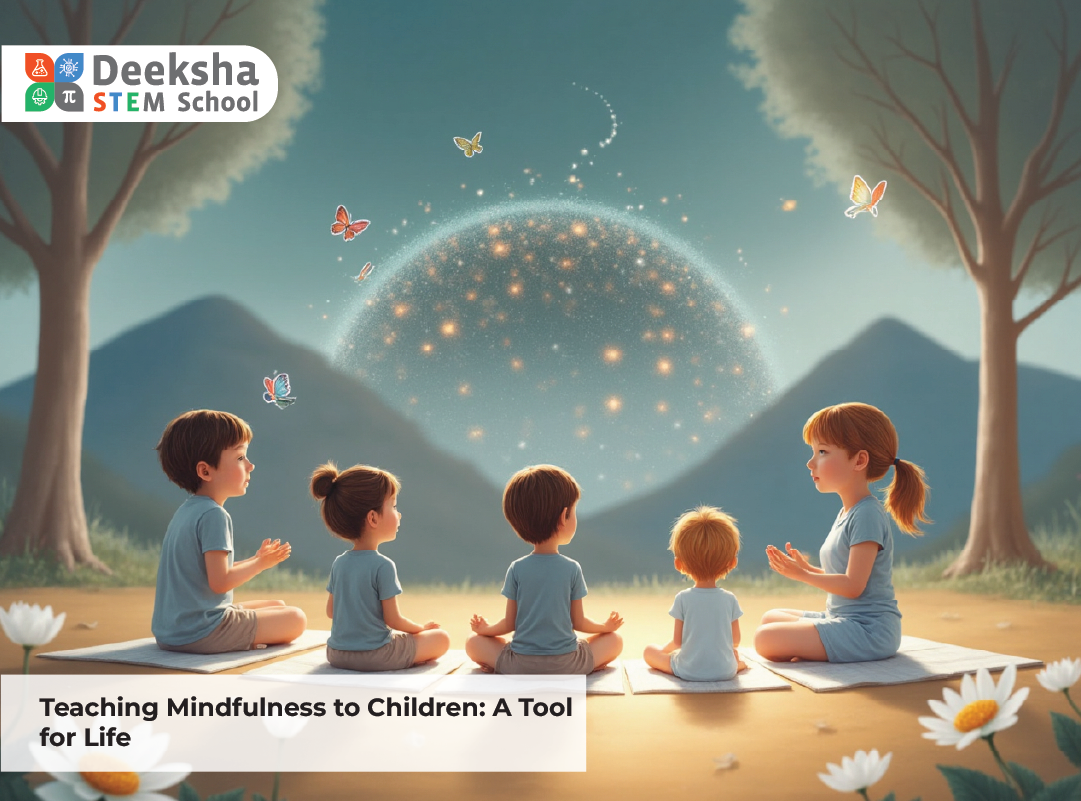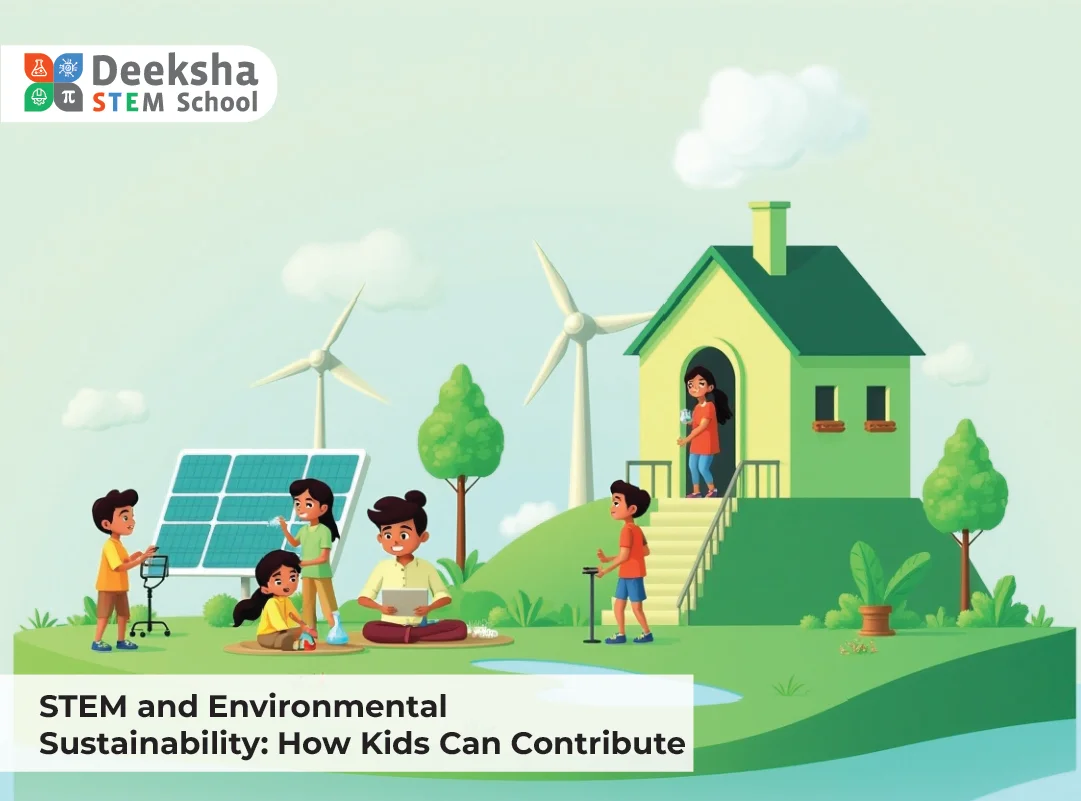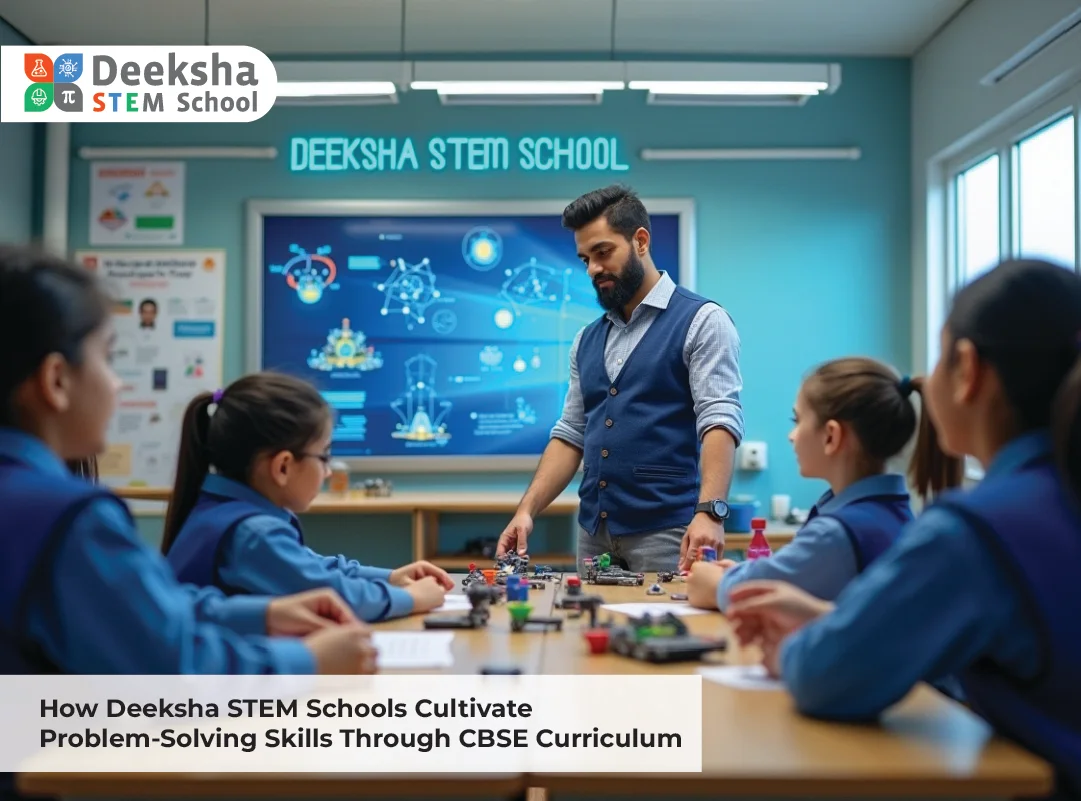Teaching Mindfulness to Children: A Tool for Life

In today’s fast-paced, digitally connected world, children are constantly exposed to stimulation—academic pressure, extracurricular demands, screen time, and even social media influences. These experiences often leave them feeling scattered, anxious, and unable to stay present. Amidst this whirlwind, mindfulness stands as a powerful anchor. It isn’t just a relaxation technique; it’s a fundamental life skill that enhances focus, builds emotional resilience, and promotes a deeper understanding of self and surroundings.
At Deeksha STEM Schools, we see mindfulness not as an add-on, but as a core element of holistic education. We embed it into the school culture so students can grow into self-aware, thoughtful, and emotionally balanced individuals. Let’s take a closer look at how mindfulness transforms young lives and how parents can support this journey.
What Is Mindfulness for Children?
Mindfulness is the practice of being fully present in the moment, aware of thoughts, emotions, and physical sensations without judgment. For children, this concept is simplified into fun, age-appropriate activities that allow them to tune into themselves. Mindfulness for kids may look like this.
- Becoming aware of butterflies in their stomach before a test
- Closing their eyes and breathing deeply when angry or frustrated
- Noticing the taste and texture of food during meals
- Immersing fully in a single activity, like drawing or listening to music
- Watching clouds drift or leaves rustle without distraction
When children engage in mindfulness, they become better at recognizing their feelings and managing their reactions. It helps them shift from impulsive responses to thoughtful actions.
Why Mindfulness Matters in Childhood
Mindfulness isn’t a quick fix—it’s a developmental tool that builds lifelong habits. Here are the key reasons why it matters:
- Improves Concentration and Focus: Mindfulness trains the brain to resist distractions and stay on task longer, which leads to improved academic performance.
- Reduces Anxiety and Emotional Overwhelm: Children who practice mindfulness are more equipped to handle stress, fear of failure, or pressure from peers.
- Builds Self-Awareness and Self-Regulation: Kids learn to recognize their triggers and choose appropriate responses.
- Encourages Empathy and Compassion: Mindfulness enhances emotional literacy, teaching children to understand others’ feelings and respond with kindness.
- Supports Better Sleep and Well-being: Regular mindfulness reduces mental chatter, helping children relax and sleep more soundly.
- Increases Confidence: Children become more secure in themselves and their abilities when they are attuned to their emotions.
How Deeksha STEM Integrates Mindfulness in Learning
At Deeksha STEM, mindfulness is woven into daily routines and academic planning—not as a separate subject, but as a seamless part of our holistic pedagogy.
| Mindfulness Practice | Purpose and Impact |
| Daily Mindful Minutes | Breathing or silence sessions before morning classes help set a calm, focused tone |
| Gratitude Circles | Weekly classroom discussions where students express appreciation and practice positive focus |
| Mindful Transitions | Short pauses between subjects help reset attention and prevent cognitive fatigue |
| Creative Visualization | Guided imagery sessions encourage mental clarity, emotional safety, and imagination |
| Movement-Based Mindfulness | Activities like yoga, stretching, and mindful walking allow emotional grounding through body |
| Silent Reading or Doodling | Independent quiet time that nurtures self-reflection and mental relaxation |
These activities ensure that mindfulness becomes second nature, not a forced discipline. Teachers guide these practices with compassion and consistency.
Practical Ways Parents Can Support Mindfulness at Home
Parental involvement plays a major role in reinforcing mindfulness. Here’s how you can build a mindful environment at home:
- Create a Calm Corner: A cozy, quiet space with cushions, calming visuals, and books where your child can unwind
- Bedtime Wind-Down Routine: Use breathing stories, body scans, or soft instrumental music to promote calmness before sleep
- Family Gratitude Practice: Share one thing each family member is thankful for during dinner or bedtime
- Practice What You Preach: Model mindfulness by being calm during stressful moments and being present during conversations
- Use Sensory Activities: Encourage slow-paced activities like mindful eating, nature walks, or finger painting
- Limit Digital Noise: Dedicate screen-free time daily to encourage quiet play, journaling, or simply being
- Mindful Breathing Rituals: Make deep breathing a part of transitions—before homework, after school, or during car rides
When mindfulness becomes a family value, children absorb its benefits more deeply and consistently.
Frequently Asked Questions
1. Is mindfulness the same as meditation?
- Not quite. Meditation is a focused practice, usually involving sitting still and concentrating. Mindfulness, on the other hand, can be practiced anywhere, anytime. It’s about being present—whether you’re brushing your teeth or walking to school.
2. Can young children really understand mindfulness?
- Absolutely. Children as young as three can understand basic mindfulness through playful breathing exercises, games like “listening walks,” and emotion cards. The key is to keep the activities engaging and language simple.
3. How long should a child practice mindfulness each day?
- Even just 5 to 10 minutes daily can produce meaningful results. The emphasis should be on creating a consistent routine rather than extending duration.
4. Does mindfulness help with academic performance?
- Yes. Mindfulness enhances executive functioning—such as working memory, planning, and attention—all of which support better academic outcomes.
5. How are Deeksha STEM teachers trained to teach mindfulness?
- Our faculty undergo regular training in mindfulness-based teaching methodologies, attend development workshops, and follow guided wellness modules to ensure that their practices remain effective and age-appropriate.
Final Thoughts
Teaching mindfulness to children is like giving them a superpower—one that helps them pause before reacting, recognize their feelings, and choose peace over panic. In a world that often values speed over depth, mindfulness anchors children in what truly matters: the present moment.
At Deeksha STEM Schools, mindfulness is not a passing trend—it’s part of our identity. Our students learn to breathe through challenges, listen with empathy, focus with clarity, and grow with intention. With every mindful moment, they build the inner toolkit to face life’s uncertainties with strength and grace.
Explore our campuses at Bannerghatta Road, Judicial Layout, Kengeri, and Vidyanagar to see how mindfulness is shaping young minds into thoughtful leaders of tomorrow.




